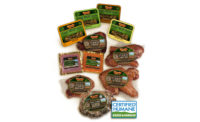Sausage Evolves with the Times
by Lynn PetraK, Special Projects Editor
Processors grind out the good stuff, with notable new flavors and formats.
Could it be that something as basic as ground meat seasoned and stuffed into casings can reflect food and food manufacturing trends in general?
It’s actually not a stretch, to borrow a category phrase, to compare trends in sausages and frankfurters to consumers’ overall demands and the ever-evolving response of food marketers.
For one thing, shoppers continue to ask for convenience. Both large brands and regional specialty companies are responding in kind. Already fairly easy products to prepare and serve, sausages also are increasingly available in pre-cooked form for preparation in a matter of seconds — and as an ingredient in heat-and-serve meal solutions for various dayparts. Pre-sliced products are coming to the fore in new ways as well.
Another notable trend is the ongoing focus on flavor. Manufacturers are spicing up sausages and their hot dog and snack counterparts in a variety of ways, from flaming hot additions to savory herb-infused ingredients. Ethnic and gourmet specialty sausages, while still outnumbered by traditional branded varieties in dollar sales and shelf space, are slowly but surely expanding out of their niche segment and are available as breakfast, dinner, and snack products in mainstream meat cases, as well as natural and specialty food stores.
As with other food products, sausages are breaking out of their longtime format —and in some instances, their casings. To be sure, links, patties, and chubs remain dominant bestsellers, but research and development professionals and marketers in many processing companies are getting creative and introducing more sizes, shapes, and even textures. For both breakfast and dinner occasions, sausages are being included as a main component of heat-and-serve entrées.
Sausage remains popular
Those are just a few of the major trends marking this mature but resilient category. For foodstuffs dating back several centuries in origin, sausages remain a remarkably popular center-of-the-plate item. They are also unique in that they are protein choices that span across all dayparts —from breakfast and snacks through lunch and dinner.
What’s more, this is a category that continues to capture new markets.
“Dinner sausages are enjoying unprecedented sales in the United States, as new flavors, convenient products, and many great-tasting old standards have enjoyed steady category growth,” reports Ayoka Blandford, manager of public affairs for the Washington, DC-based National Hot Dog and Sausage Council, a project of the American Meat Institute Foundation.
Karen Boillot, director of retail marketing for the Des Moines, IA-based National Pork Board, agrees that indicators are positive, at least for pork-based sausages that the group tracks. “The sausage category has continued to grow at the fresh-meat case, and it is now about seven percent of total meat case tonnage and eight percent of the [retail] dollars,” she says.
Part of the energy of the category can be linked to more aggressive merchandising at the retail level, Boillot adds.
“When we look at the two-year trend, sausage is up 5.7 percent in terms of feature support. Retailers are realizing that sausage is a viable destination and an item that consumers want,” she says. “I think it has gained enough mass in the meat case to be its own recognizable category.”
The growth in retail channels stems from pooled efforts of all types of sausage manufacturers. Large brands, many marketed by food industry conglomerates, continue to roll out products, emphasizing new flavors, precooked options, meal solutions, and convenient packaging.
Smaller or “boutique” companies, meanwhile, are fueling the increase in non-traditional varieties and formats.
“The specialty sausage category is among the fastest-growing categories in sausage, and we believe that it is attracting all types of consumers,” points out Amy Kurzawski, owner, chief executive office, and creator of Chicago-based Sausages By Amy, which sells its specialty sausages through supermarkets as well as foodservice operations. “From people looking to make a break from ‘basic’ sausages to consumers focusing on the healthy aspects of our products, we are constantly growing the category for our retail partners.”
A review of recent market data supports the fact that, at least in the retail arena. Both established names and up-and-coming brands are making the category one to watch. To start with, the breakfast-sausage category notched a 2.3 percent increase from the end of 2003 to the end of 2004 for total dollar sales of more than $887 million. The dinner sausage segment, traditionally the strongest for the entire category, rang up more than $1.5 billion in sales for the same time frame, a 4.4 percent bump. Beyond the fresh retail meat case, frozen sausage sales jumped 12.2 percent to about $234 million.
Those numbers actually may be understating the market for sausage as a whole, due to supermarket research gathering techniques based on SKU scanning, Blandford says. “Scan data collected in homes is projected across the population. However, many sausage products are sold as ‘random weight’ items, meaning retail packages are not of uniform weight and often not tracked by scanners,” she explains.
Although sales are strong and many brands are reporting upswings in dollar sales, the near-euphoria over the past two years of high-protein diets has abated. Low-carb diets, once the rage of the nation, have lost their water-cooler appeal. The percentage of Americans saying they adhere to low-carb eating plans dropped from a high of 9.1 percent in February 2004 to 4.9 percent by November, relays research firm The NPD Group.
Still, marketers of products like sausages, hot dogs, and meat snacks point out that consumers are more educated about the impact of excess carbohydrates and the importance of protein.
“The low-carb buzz has passed, but we are seeing across the board that carb-conscious categories have reached a much higher base level of consumer interest and takeaway than prior to the recent carb-crazed times. Therefore, consumers are still carb conscious, but they may have trouble strictly adhering to a low-carb diet,” points out Scott Eckert, vice president of marketing for Swift & Company, Greeley, CO.
Other meat marketers share that opinion. “The trend certainly has moderated, and people seem to be looking at complex carbs instead. They are more aware of good carbs versus bad carbs,” says Nancy Cowen, director of marketing for Columbus, OH Bob Evans Farms. Adds Tom Cherchek, president of Cher-Make Sausage, Manitowoc, WI: “They say it peaked, but people are still using some sort of modified approach. They may have a chunk of pizza with crust for dinner, but our research shows that they are slicing our summer sausage product, for example, and enjoying it as a snack.”
The renewed interest in sausages, along with related processed meats like frankfurters and meatsnacks, means that this is a category with even more potential.
“I think across the board, everyone is looking at ways to gain more sausage space in the meat case. I think pre-cooked items are a way to do that, but also some of the different flavor profiles grab consumer interest,” notes Boillot.



Report Abusive Comment